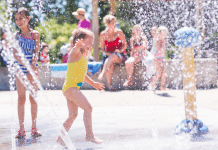It’s mid-July. If you are parents of a three to seven or eight-year-old, you’ve likely been to the zoo, the park, and the pool dozens of times since school has let out and you have also possibly exhausted your home arts and crafts stash by now. The children (and maybe even the adults) are starting to get a little restless. You may have heard at least one “I’m bored” slip out of at least one child’s mouth. You sense the summer slide is coming and you are desperate to avoid it.
Here are three suggestions to help avoid the summer slide in your home.
Nature Walk Sketch and Writing
If you have a blank notebook or notepad lying about (if you don’t, Target dollar bin has some all ready for back-to-school supplies!), hand the kiddos a pencil and the notebook and take a walk around your neighborhood. Have children sketch a few items that catch their eye. Give them categories: a plant, an animal, an object. Or, break this up over the course of several days and have the children find an object for every object of the alphabet.

Then, at home, have them color in (if they wish) their sketches.
- If they have found an object or several, have them make up a story using all the items.
- If they are doing a letter at a time, have them write a sentence using that letter/object.
- For children working on sight words, have them use certain sight words in their story or sentence.
- For children working on writing their letters (uppercase/lowercase), have them tell you a sentence or two per story that you can write out and then they can copy on their page.
Don’t have time to sketch right there? No problem! Use that smart phone and snap pictures they can pull up and sketch later when you have more time.
Skills that help avoid the summer slide:
- Alphabet practice.
- Upper and lowercase letter writing.
- Sight words.
- Writing sentences.
- Practicing punctuation.
- Imaginative story telling.
Virtual Learning for the Summer Slide

Check out the online virtual learning classes of Outschool. Some classes are single course offerings and others meet more than once.
Children meet with an instructor and other students in a virtual space and learn about, and get practice with, a variety of topics, from Introductory French and Learning to Play the Piano for 5-8 year olds to one-time courses like Learn to Draw Cute Animals or Creatures of the Deep Ocean for students as young as four. Most classes meet for one hour and have varying interactions with other students. Courses are as low as $10 per learner per course.
Skills that help avoid the slide:
- Engagement in exploration of an activity.
- Being engaged in learning a new skill or information.
- Some course options include math, writing, language, or even ideas like Mindfulness.
Museum Exploration
If you live in San Diego County, summer could be a great time to explore the Resident Free-Tuesdays in Balboa Park.
July 16: San Diego Museum of Art, San Diego Museum of Man, Japanese Friendship Garden, Timken Museum of Art (always free)
July 23: San Diego Air & Space Museum, San Diego Automotive Museum, San Diego Art Institute, several International Cottages, Timken Museum of Art (always free)
August 6: Fleet Science Center, Centro Cultural de la Raza, San Diego Model Railroad Museum, San Diego Natural History Museum, Timken Museum of Art (always free)
August 13: Museum of Photographic Arts, San Diego History Center, Veterans’ Museum and Memorial Center, Timken Museum of Art (always free)
August 20: San Diego Museum of Art, San Diego Museum of Man, Japanese Friendship Garden, Timken Museum of Art (always free)
August 27: San Diego Air & Space Museum, San Diego Automotive Museum, San Diego Art Institute, several International Cottages, Timken Museum of Art (always free)
Prior to the visit:
- Choose a few pieces or exhibits you want to be sure to see and do some exploration of their history prior to the visit by checking out library books on the topics or artist.
- If the museum is a cultural museum, find books or related resources about that culture and do some reading (children’s picture books are great for this) prior to the visit.
- Talk with children about the museum ahead of time and ask them what they might expect to see or what they think they might learn.
During the visit:
- Make it engaging and interactive for the children even if it’s a “hands-off” space.

photo credit: Michal Parzuchowski @mparzuchowski - Prepare a museum “scavenger hunt”.
- Have children pose with or near famous paintings and re-create what they see.
- Bring that sketchbook and have children draw their version of items in the museum they see.
- Get a couple of those disposable cameras and let your children take their own flash-free photographs they can develop for later and even, write more stories about.
After the visit:
- Re-visit those initial questions: did they see what they expected? What surprised them? Excited them? What did they love to see the most and why? Ask children to write about their experience or even write a thank-you note to the museum itself!
Skills that help avoid the slide:
- Pre-reading and writing based on the topics you will see.
- In-depth experience with topics in art, history, and science.
- Critical thinking and imaginative learning.
- Storytelling and question-asking.
Need some more tips on avoiding the summer slide? Click here!



















